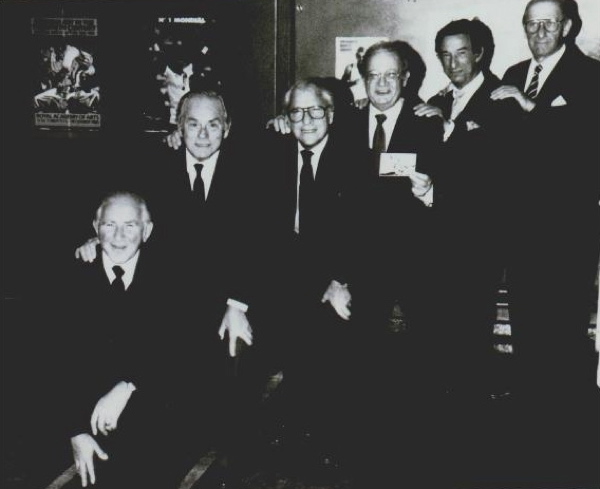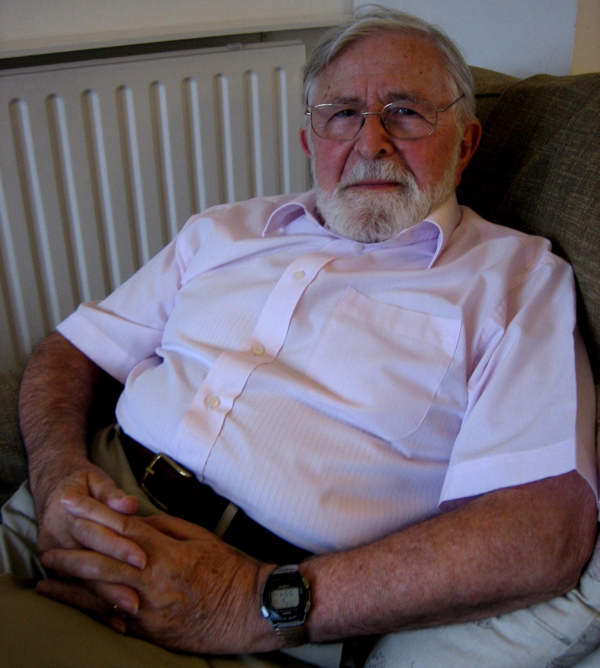So Long, Ron Goldstein
Ron Goldstein died last Saturday 29th May at the fine age of ninety-seven

If – like Ron Goldstein – you were your parents’ tenth child, growing up in a tiny terraced house with a clothing factory on the top floor in Boreham St, Brick Lane, and sharing a room with your three elder brothers, then you might also be impatient to join the boys’ club round the corner in Chance St and have somewhere to let off steam and have fun. Even though strictly you had to be eleven, Ron was able to join the Cambridge & Bethnal Green Boys’ Club in 1933 when he was only ten, because his older brother Mossy was a Club Captain and pulled a few strings.
At this moment a whole new world opened up to Ron. For the price of a halfpenny a week subscription, each night he would be in the front of the throng of boys waiting impatiently in Chance St for the seven o’clock opening of the Club, hungry for fulfilment of the evening’s promise. Squeezing past the office where membership cards were checked, he went first to the canteen in the hope of wolfing a tasty saveloy, while others were already getting stuck into a quick game of table tennis, before the photography class started at seven-thirty. This was the primary focus of the evening for Ron – because as you can see from the picture above, he was the proud owner of a box brownie that he bought for two shillings from Woolworths. Harry Tichener, who ran the classes, was a West End photographer who inspired his East End pupils by teaching them how to use and develop colour film before most people had even seen a colour photograph – encouraging a lifelong enthusiasm for photography in Ron. At eight-thirty sharp the photography class was over, and it was time for Ron and the others to enjoy a brisk run down Bishopsgate to the Bank of England and back again without stopping, followed by a refreshing shower at nine-thirty, then a prayer in the gymnasium before going straight home to bed in Boreham St.
And so at ten years old, life acquired a totally new momentum for Ron. It was so special to him that even today, more than seventy years later, he remains close friends with many of the boys he met then and they are still enjoying regular happy Club reunions, celebrating the lifelong friendships that were forged at the Club.
Opened in 1924 by altruistic undergraduates as a Jewish Boys’ Club, the Cambridge & Bethnal Green Boys’ Club had an ethical intent from the beginning, adopting the motto, “serva corpus, cole mentem, animam cura,” – keep fit, cultivate your mind, think of your soul. These lofty ambitions were reflected in the lively range of activities on offer, including, boxing, art, photography, gym, travel talks with lantern slides, dramatics and play reading, harmonica classes, health lectures, first aid lessons, hobbies, science lectures, swimming, shoe repair, philately, essay writing and debating.
In retrospect, Ron fondly appreciates the raising of expectations that the Club encouraged, “Half of the boys would have ended up as the next generation of gangsters and criminals if it had not been for the Club. It was our first time to mix with people who never had to work from an early age and our first chance to consider the ethical side of life. We were a bunch of young tearaways. The Club managers from Cambridge had a very upper class way of talking and we used to take the mickey, but it was different at the weekend camps, everyone dressed the same and we all mucked in together.”
The photographs speak eloquently of the joy engendered by the Club and of the easy affectionate atmosphere, creating a warm playful environment in which the boys were able to feel free and enjoy the respect of their peers. Each weekend there were rambles when the boys took their cameras and enjoyed afternoon hikes within striking distance of London, stopping off at pubs to quench their thirst with half pints of shandy. During Summer weekends there were camps, when everyone travelled down to the country together, set up their tents, cooked meals and enjoyed outdoor pursuits, returning to the East End weary and sunburnt on Sunday night. Once a year, this was extended to a week’s Summer Camp at a more exotic location such as Frome or Banbury or Wimbourne. Ron only attended two Summer camps but he also recalls with delight the year he was disappointed, when he was unable to go due to a strained heart muscle that confined him to the Royal London Hospital. To his everlasting delight, a basket of fruit from Fortnum & Mason arrived from one of the Club’s wealthy patrons and no-one in the hospital had ever seen such a generous gift to a teenage boy.
When the twin Lotinga brothers, George and Rowland took over in 1936, they removed the Jewish prerequisite of membership of the Club, opening it to everyone, as a radical and egalitarian response to the rise of antisemitism, manifested by Oswald Mosley and the fascists in the East End. In this context, the playful Club photographs take on another quality, because there is something noble in the existence of a social space devoted to nurturing human sympathy, created while others are setting out to breed hatred. The boys were not unaware of the value of their freedom either, as evidenced by the seventeen year old lad that Ron remembers, who told his mother he was going on a weekend camp with the Cambridge & Bethnal Green Boys Club but ran away to fight in the Spanish Civil War instead.
At thirteen years old in 1936, Ron started in Fleet St as a runner for the Associated Press Picture Agency which required working evenings and limited his opportunities to attend the Boys’ Club. But he remained a member until war broke out in 1939, attending the Camp at Greatstones, Hythe at the age of sixteen, during that famously beautiful last Summer before hostilities were declared. These photographs are especially poignant, recording the final moments of a carefree youthful world before it was destroyed forever.
When war commenced, Ron’s father moved the family out of London to Hove and before long Ron and many other members of the Club found themselves enlisted. Some achieved heroism in the service and many died, while others came to prominence in post-war civilian life, yet although the Club finally closed in 1990, there are still enough members of the Cambridge and Bethnal Green Boys’ Club around to remind us of this honourable endeavour which set out to encourage the best in people, despite the tyranny of circumstance.

Waiting in line in Chance St on a Winter’s night for the club to open at seven o’ clock.

George and Rowland Lotinga surrounded by members of the club in Chance St, with Harry Tichener extreme right.

On a visit to Parliament in 1935 as guests of Sir Percy Harris, Liberal MP for Bethnal Green, seen on the right. Ron is the second boy standing to the left of Club manager, Derek Merton.

On a Sunday ramble through the outskirts of London.

Fourth from the left in the front row, Ron cradles his camera on this ramble led by photographer Harry Tichener, who ran the Club all through World War II when the younger managers were enlisted.

At Summer Camp, Ron is riding in the rumble seat at the very back of this car belonging to Harry Moss of Moss Bros. Passengers from left, George Lotinga, Harry Moss, Ronny Coffer, Dave Ross, Mick Goldstein, Syd Curtis and Ron.

A happy scene at Greatstones Summer Camp 1939 with Dave Saunders (bending at centre) and Monty Meth, current chairman of the old boys’ club (bottom row, right, in a dark blouson)

Mealtime at Greatstones Summer Camp 1939.

A race in Victoria Park in 1938, with Odiff Fugler making headway on the left and Dave Saunders in the centre.

High jinks at the Greatstones Camp Tuck Shop 1939.

The cook makes dough in a field at Greatstones – note the makeshift stoves in the background.

Cecil Bright, Dave Ross, Sid Tabor, Freddy Oels, Dave Summers, Monty Griver and Mick Goldstein (Ron’s brother).

More recently, Cecil Bright, Dave Ross, Sid Tabor, Dave Summers, Monty Griver and Mick Goldstein.

Ron was part of the Club’s Harmonica group named “The Four Harmonica Kids.”

Ron Goldstein (1924-2021)
You may also like to read about
At the Cambridge & Bethnal Green Boy’s Club 86th Renuion Dinner
At the Cambridge & Bethnal Green Boys’ Club 89th Annual Dinner
At the Cambridge & Bethnal Green Boys’ Club Final Dinner
and my interviews with members of the Cambridge & Bethnal Green Boys’ Club
and watch















RON GOLDSTEIN (1924-2021) — R.I.P.
A great institution was this Boys’ Club, when after decades the memories are still as present as they were with Mr Goldstein.
Love & Peace
ACHIM
A fascinating history, and some great images. May you rest in peace Ron Goldstein
A full life, well lived. RIP
Another well lived and interesting life has passed into history.
I’m sure Clubs like this would improve the lives of a lot of young boys today. There is just so much aggression around that could be channeled into something positive.
Greetings from Boston,
GA, what an inspiring story about Ron Goldstein and his friends enjoying life and expanding their horizons at the Cambridge & Bethnal Green Boys Club in the pre-war years. Surely that experience was a saving grace for many.
Wow, that must have been a thrill to receive that fruit basket from Fortnum and Mason while Ron was in the hospital.
Great pics, great story…
The story and the photos of the Boys’ Club are superb and made so many happy memories for those who participated. Thank you for sharing Ron Goldstein with us.
Thank you for introducing us to Mr. Goldstein, and providing these wonderfully-spirited photos. The Boys Club was a huge factor in our small town, outside the city of Pittsburgh, and was very influential in the lives of boys I knew. (and still know! Great to have friends from childhood.) There was a dizzying array of sports activities, and I especially recall the boys showing off magic tricks they learned from a local magician who “consulted” at the Club. Local, regional celebrities…….like the infamous wrestler Haystack Calhoun!…… stopped by and provided weight-lifting advice and sponsored friendly competitions, etc. Basketball – yes. Riding around in trucks, putting up flags for patriotic holidays – yes. Committees to care for the building and equipment – yes. The Boys Club was a nexus for boys looking for a second home, and a place to meet friends and expand horizons.
These fantastic photos are evocative of joyous times, skinned knees, belly laughs, and
lifelong memories. As I look into these young happy faces, I also see echoes of the boys I knew in childhood. Many thanks.
Very interesting. May Mr Goldstein Rest In Peace.
Those local clubs set many in the East End on the road to success. We need them now.
Surprisingly (to me) neither Boreham St nor Chance St appear anywhere in London in early postwar A-Z maps, unaffected (I believe) by bomb damage. I wonder when they were replaced.
I remember Max Lea, a mainstay of the Parmiters school football team and of the boys club Goldstein belonged to. These people did good.
Sorry to hear this; sincere condolences and wishes for long life to his family. Only a fleeting, passing email acquaintance a couple of years back, as my grandparents lived in premises similar to Ron’s – he sent me some pencil sketches of his house. Not unusual at the time, of course, for so many people… Rest in Peace